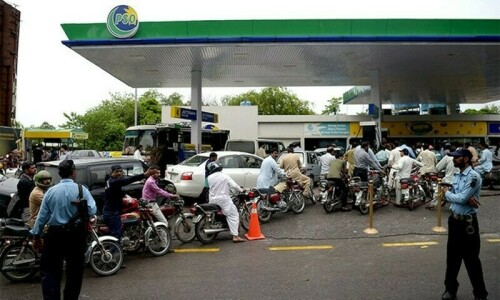ISLAMABAD For the following two weeks, there will likely be a little increase in fuel and high-speed diesel (HSD) costs per litre, predicted to be caused by small changes in international pricing, import surcharges, and currency rates on Thursday, February 29.
According to knowledgeable sources, during the previous two weeks, the prices of the two main petroleum products—gasoline and heavy synthetic diesel (HSD)—moved somewhat in both directions on the global market, ranging from 10 to 50 cents per barrel. As a result, Pakistan State Oil (PSO) was required to pay higher import premiums on gasoline.
Thus, depending on the final exchange rate computation, the price of gasoline is predicted to be Rs3–4 more per litre than that of HSD by Rs1–1.5 more per litre. On February 28, the US dollar fell against the rupee by roughly 15 paise. Kerosene and light diesel oil prices are anticipated to stay steady.
For the purpose of calculating prices, officials reported that during the previous two weeks, the price of gasoline increased by roughly $0.5 per barrel to $90.78 from $89.20 per barrel, while the price of HSD decreased by around eight cents per barrel to $101.05 from roughly $101.13. In contrast, the value of the rupee was quite steady. For gasoline, the premium that the PSO paid to secure product cargoes increased little, from $9.47 per barrel to $10.45 per barrel this fortnight. At $6.5 per barrel, it did not alter for HSD.
The maximum amount allowed by law, which is Rs60 per liter for both gasoline and HSD, has already been reached by the government. In accordance with agreements reached with the International Monetary Fund, the government had set a budget objective to collect Rs869 billion as a petroleum levy on petroleum products for the current fiscal year.
Despite a steady increase in the per-litre fee, it has already earned almost Rs475 billion in the first half of the fiscal year, which runs from July to December. Although the reduced target has now been set at Rs920bn by end-June, the government is still anticipated to collect over Rs970bn by year’s end.
The consumer price index indicated that the high rate of inflation in January was 27.5 percent. The main causes of this increase were the costs of petroleum and electricity.
The majority of private transportation, tiny cars, rickshaws, and two-wheelers run on gasoline, which directly affects middle-class and lower-class budgets.
However, because HSD is largely utilized in heavy-duty trucks, buses, tractors, tube wells, and threshers, as well as trains and heavy-duty vehicles, its price is thought to be extremely inflationary. In particular, it drives up the cost of produce and other food items.
Currently, the government taxes gasoline and HSD at a rate of roughly Rs82 per litre. The government charges Rs60 per liter PDL for both items, even though general sales tax (GST) is 0% on all petroleum products.
However, it charges Rs50 per litre for 95RON gasoline and a high octane blending component. Additionally, the government levies a customs fee of roughly Rs. 17–20 per litre on gasoline and HSD. With sales of roughly 700,000 to 800,000 tonnes per month compared to the monthly requirement of just 10,000 tonnes for kerosene, gasoline and HSD are significant cash generators.








